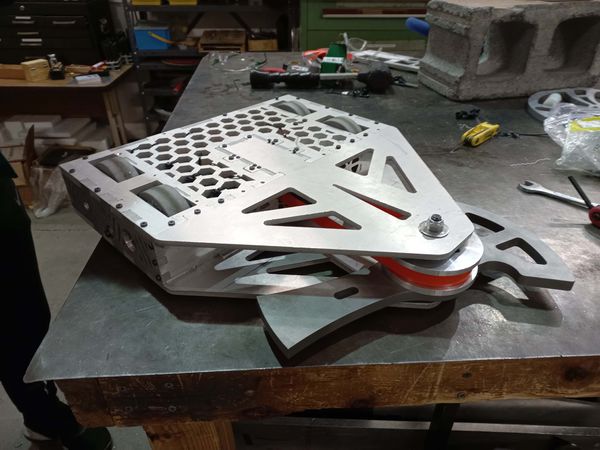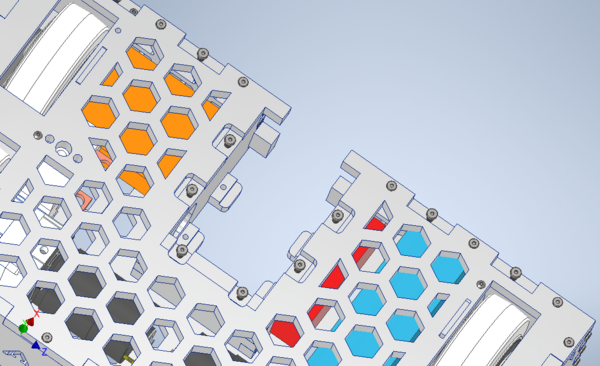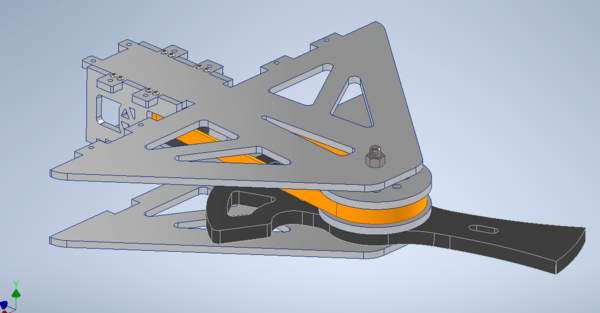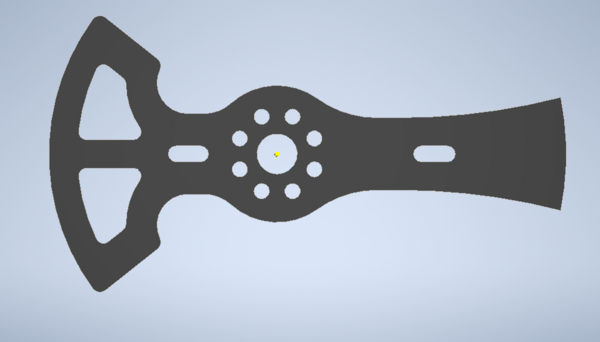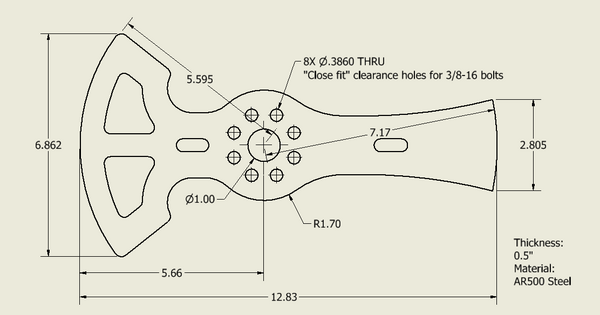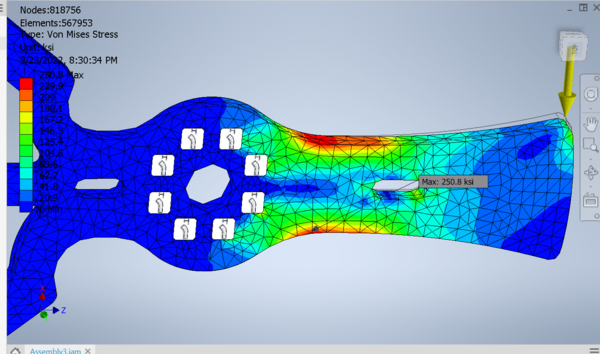Anarchi
Contents
Introduction
Anarchi was supposed to be an experimental 30lb bot where it's primary weapon could be switched between a horizontal spinner and a drum spinner via weapon modules that would be held by the chassis using a modular interface. Unfortunately, due to the poor member retention throughout the semester, the team was unable to manufacture the drum spinner module and was only able to finish the horizontal spinner module before competing in AVC 2022.
Members:
- Dylan Adriano (Bot Lead)
- Brian Naing
- Cade Tyler
- Jackson Isenberg
- Lucas Luwa
Chassis
Main Chassis
Modular Interface
The modular interface is the crux of the modular robot design. The interface was designed for the ability to slide the weapon module into the center of the robot and then attach it using bolts into threaded holes. Through this universal interfacing design, any weapon module following this interface could slide into the chassis. A benefit of this design is that is relatively simple and only requires that very simple attachment mechanism to fit any weapon module so long as it follows the universal interface design. This was (supposed to be) Anarchi's major selling point -- that the robot could work with any weapon design.
The main problem with the interface is the fact that it requires very precise manufacturing to maintain assembly strength and allow for the weapon module to be inserted and removed easily. This became a very difficult engineering challenge, especially since we did not properly consider tolerances when designing the chassis. As a result, we had to file down the puzzle fits and interface sides in order to even fit the pieces together.
Another problem was that the interface did not consider factors such as center of mass or weapon height, which was especially troublesome when we wanted to try designing a vertical spinner. The interface was not well equipped to handle major changes in the center of mass of the robot and therefore limited what kinds of weapon were viable for the interface.
Horizontal Spinner Weapon Module
Drum Spinner Module (Never Started)
Drive System
Design Considerations
Shell Design
Shell was milled out of a 250 lb block of A36 steel. It took forever but was very effective in absorbing damage.
Pros:
Cons:
Weapon Systems
Horizontal Spinner Module
Horizontal Spinner Weapon Bar
Design:
Anarchi's horizontal spinner module utilized an asymmetrical style weapon with a longer impactor end and a wide counterweight to keep the center of mass along the axis of rotation, causing it to resemble a hammer. However, the impactor design was not made with a specific rake angle in mind but it was later measured to be 3.1 degrees. relief angle was also not considered in the design and was 0 degrees which may or may not be ideal. The weapon was made asymmetrical as it would increase the average bite (weapon insertion distance into opponent) by a factor of 2, improving the energy transfer to the opponent upon impact. the weapon It was 0.5" thick and made of AR500 steel which is considered one of the best materials for weapons that can be made via the waterjet. It weighed 4.509lbs and had an MOI (moment of inertia) of 74.825lb*in^2.The impactor ends were designed to sharp as they were intended to bite into opponents' armor better however its effectiveness didn't get the chance to be properly proven. It is constrained via 8 3/8-16 bolts that fasten it securely onto the pulley. The holes are "close fit" clearance holes (you can select a "close" option using hole wizard in Inventor) and in theory would allow a good bit of play if it weren't for the waterjet taper making the holes slightly smaller in reality. If you plan on trying to waterjet AR500 with closer fit clearance holes, it is essential that you do test cuts beforehand because AR500 is extremely difficult to machine. The hole in the middle is an inch long in diameter and was meant to allow a generous amount of clearance between the stationary spacers and the spinning steel weapon. Below is a useful pic of some basic dimensions.
Analysis:
WARNING: The following analysis was not conducted by an FEA expert so please be aware that the approach may be inaccurate and/or incorrect so be very skeptical.
Rudimentary FEA was also conducted with an arbitrarily large load applied to a corner edge of the impactor and the weapon being constrained via 8 dowel pin parts where the contacts/constraints for the weapon were applied to simulate the bolts. It was found that the greatest stress occurred along the curvature between the central outer diameter and the length of the impactor similar to a cantilever beam with a constant end load. It was found that the greater the value of the curvature radius, the lower the max stress. An interesting thing to note is that the reaction forces on the contacts were calculated to be the greatest on the two rightmost bolts, 2nd greatest on the two bolts immediately to the left of them, and lowest on the bolts to the left of the center. This lead to the assumption that it was imperative to make the bolts be as large as reasonable to minimize the shear stress on the individual bolts to minimize the chances of the first two bolts on the right of the center failing. 3/8-16 bolts were selected due to the fact that they were the largest reasonable sized hole we could fit within the given geometry and that we already had taps for them in the shop.
A key element of designing an asymmetrical weapon is making sure the non impactor side won't be making contact with the opponent before the impactor does. The theory of bite is discussed in detail starting on page. 158 of the Riobotz Combot Tutorial. Our calculations, as linked below, assumed that the robot driving velocity would be 16.7mph and that the max rpm would be around 6528rpm. These values were produced by the Team Just'Cuz Robotics drivetrain calculator and the runAmok Spin-up calculator and as a result, both are not very accurate to real life (both better theoretical and validated models need to be developed). Based on the bite equation presented on page 158, our dmax was calculated to be 2.574803 inches with the average bite being 1.2874015 inches. Where our calculations differ from the Riobotz Combot Tutorial is that we check to make sure that the minimum distance at the point in the rotation where the weapon counterweight starts to pull away from the opponent is greater than zero to ensure that contact won't be made as this is the closest they will be to each other. We just made sure that this distance was greater than 0 since we knew the drive was going to be slower but it would be recommended to use some sort of safety factor for this in the future.
Manufacturing:
The weapon was waterjetted out of an approximately 0.5" thick AR500 steel shooting target from makeittargets.com. Make it ring targets don't have a super tight tolerance on their plate thicknesses as ours measured around 0.491" thick. The settings used on the waterjet cut are listed below and yielded very satisfactory results given the weapon didn't need to hit any tight tolerances unlike the press fit D-shape that Binari's weapon needed. In addition, most of the contours were cut on quality 3 while the clearance holes were cut at quality 5 since they would have to interface closely with the bolts. It's recommended to cut the "teeth" contours at a higher quality. The cut took approximately 58 minutes but we had no issues with it. The overall geometry came out nicely and the weapon was well balanced with no perceptible vibrations in the bot upon spinning up. The weapon was sandblasted to get rid of rust and mill scale which resulted in a clean, matte finnish.
Waterjet OMAX Make Cut Settings:
Material: Tool Steel D2 (RC 60)
Machinability: 54.08 (Metal)
Thickness: 0.55in
Tool Offset: 0.0125 inches
Performance:
- Weapon was very well balanced when spinning up.
- Due to drive not working well, anarchi's weapon was never able to achieve it's maximum possible bite, and therefore a really good hit, in its matches
- Waterjet taper made the holes slightly smaller than in CAD, resulting in little play, keeping the weapon pretty axially-symmetric with the pulley
- Sharp edges of impactor teeth started blunting slightly after the first two matches although this did not seem to off-balance the weapon any noticeable amount.
- Overall geometry of the weapon held up very well and no perceptible deformation was observed in the overall shape.
- Due to the ratio of bot wideness to weapon length, the area of protection/attack given by the weapon in the front of the bot was smaller than counterparts such as BEAM. Consider increasing weapon diameter or reducing bot width.
- The 8 3/8-16 bolts could possibly be overkill as some other horizontal spinners like BEAM have used configurations with slightly smaller and fewer bolts.
- Design wasn't made with a specific rake angle or relief angle in mind. The greater the rake angle, the better the weapon will be at biting into the opponent and transferring energy at the cost of blunting faster. If the rake angle is too large, it can make the teeth more fragile.
- A member from Hypershock recommends that the impactor side of weapons like that be flat on the end in order to prevent the insertion edge from prying itself out of an enemy bot's armor.
- Advantage of having weapon weapon being symmetric around the line between the impactor and counterweight is that you have two impactor teeth instead of just one meaning you can flip it around in case one of the teeth gets too blunted which would be a bigger problem given a larger rake angle. Issue is that you can't implement a large relief angle if you do that so it's a tradeoff. Relief angles also make the teeth weaker.
- Weapon was relatively light (under 20% of total weight) due to modular interface taking up weight. Will have hit harder if bigger. Many bots do between 20-33% of total weight.
Horizontal Spinner Weapon Assembly
Electronics
| Drive Motors | geh
|
| Drive Motor Controllers | Sabertooth Dual 25A 6V-24V Regenerative Motor Driver |
| Weapon Motor | Horizontal: Scorpion SII-4035-250KV, Drum: HKIV-4025-1100KV |
| Weapon Motor Controllers | HobbyWing Platinum PRO V4 120A ESC |
| Receiver | Hobby King 2.4Ghz Receiver 6Ch V2 |
| Remote Control | Hobby King 2.4Ghz 6Ch Tx and Rx V2 |
| Battery | Zeee 22.2V 60C 4000mAh 6S Lipo Battery |
Competitions
AVC
- Results: 1-2
- Bracket Style: Double Elimination
- [Anarchi (loser) V.S. Wedgeham (loser): YouTube Link]
- Match started with Wedgeham overwhelming Anarchi with it's superior driving by raming into us and pushing us into the wall repeatedly
- Anarchi never tried to spin it's weapon up to maximum velocity due to the fear of self damage.
- Anarchi landed a few small hits on wedgeham but none enough to do any significant damage due to the weapon not being able to reach it's max velocity
- Half-way through the match, the gear boxes got internally damaged, slowing down our drive and our ability to move
- When time hit 3 minutes, Wedgeham was the decided winner due to it being able to prevent us from spinning up or moving properly
- After the match, it was determined that the left drive motor would no longer spin the drive wheel when above 60% throttle
- We were unable to repair the gearboxes as the bot would have to be mostly disassembled in order to access them. The issue likely could've been solved if we had been able to easily open up the gearboxes
- [Anarchi (winner) V.S. Dragon Fruit (loser): YouTube Link]
- Drive was much slower and harder to control. Had to slowly move anarchi towards the opponent
- DragonFruit had a spinning active weapon and drive but seemed to also have some slight driving issues
- Weapon was able to spin up to a high enough speed to rip off DragonFruit's wheel resulting in them tapping out.
- After this match, orange powder from the polyurethane flat belts grinding against the inner side plate had formed and the bearings didn't spin as cleanly as previously (they felt slightly crunchier)
- Weapon had suffered a small amount of blunting around the edges that made impact.
- [Anarchi (loser) V.S. Crippling Depression (winner): YouTube Link]
- Drive had almost completely failed. Anarchi was unable to fully drive to the starting zone
- Crippling depression fought in overcutter mode to likely avoid unnessecary damage to itself as Robert Cowan knew our drive was no longer working and he had matches left
- Weapon was unable to spin up to a sufficient speed due to Crippling Depression's constant ramming. Crippling depression kept ramming us until our drive would not work at all.
- More orange powder had formed and the weapon bearings now felt significantly more crunchy and spun less smoothly. In a perfect world, they should've been replaced before this match.
- [Anarchi (loser) V.S. Wedgeham (loser): YouTube Link]
- Bracket Style: Double Elimination
Issues
- Stuff
- Other Stuff
Changes to make
- Stuff
- Other Stuff
Trivia
- The Vectrax was rendered inoperable twice by Chonki members (mainly Brian) during its construction.
